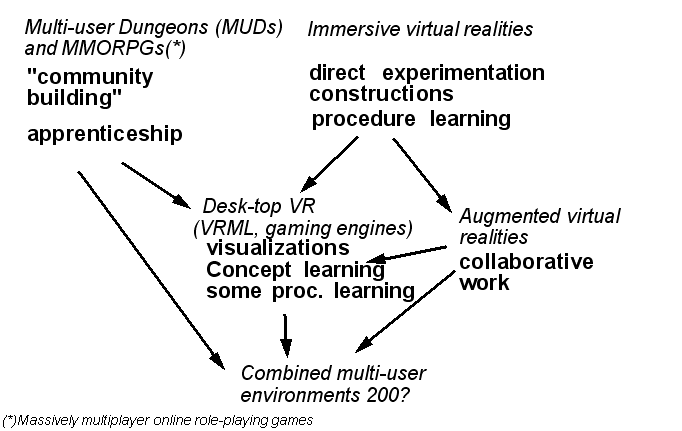Virtual environment: Difference between revisions
Jump to navigation
Jump to search
m (Reverted edits by Uzman (Talk); changed back to last version by Daniel K. Schneider) |
m (→Definition) |
||
| Line 2: | Line 2: | ||
{{disambig}} | {{disambig}} | ||
{{Comment | Note: [[User:DSchneider|DSchneider]] is not happy with the organization of wiki entries dealing with virtual environment issues .... have to come up with clear terms and decide ''where'' to write}} | {{Comment | Note: [[User:DSchneider|DSchneider]] is not happy with the organization of wiki entries dealing with virtual environment issues .... have to come up with clear terms and decide ''where'' to write}} | ||
== History == | |||
See Raph Koster's excellent [http://www.raphkoster.com/gaming/mudtimeline.shtml Online World Timeline] | |||
== Definition == | == Definition == | ||
Revision as of 15:35, 29 March 2007
- Note: DSchneider is not happy with the organization of wiki entries dealing with virtual environment issues .... have to come up with clear terms and decide where to write
History
See Raph Koster's excellent Online World Timeline
Definition
A virtual environment is a place with things that can be manipulated and people :).
Types of virtual environments (in random order):
- text-based virtual reality, such as MOOs and MUDs
- mixed reality environments
- Multi-user games with persistant storage features (mostly MMORPGs)
- Multi-user 3D interactive environments with persistant storage capabilities
- Immersive 3D environments, i.e. true immersive virtual reality environments
- any other form of virtual habitats
- Collaborative virtual environments (CVEs) - this includes habitats like MUDs, MMORPGs as well as some CSCW systems.
- Shared spaces
See also:
Typology of virtual environments
There is no real consensus on what constitutes a virtual environment. See also Benford's categorization of shared spaces.
Here is a picture made by DSchneider that shows a variety of such environments and their potential for education:
References
- Dieberger, A. (1999) Social connotations of space in the Design for Virtual Communities and Social Navigation. In Munro, A., Höök K. & Benyon D. (Eds), Social Navigation of Information Space, pp. 35-54. Springer: London
